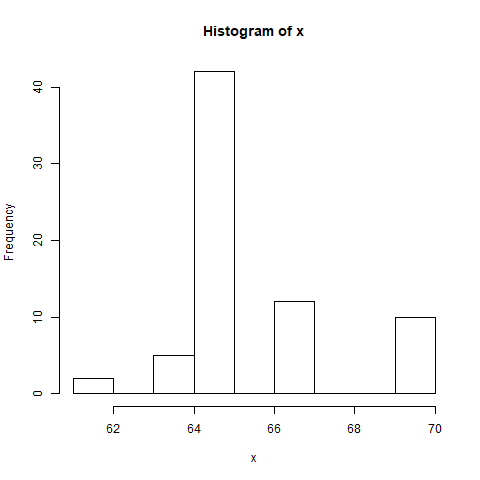R 编程中的偏度和峰度
在统计学中,偏度和峰度是描述数据分布形状的度量,或者简单地说,两者都是分析数据集形状的数值方法,不像绘制图形和直方图是图形方法。这些是用于检查分布的不规则性和不对称性的正态性检验。要在 R 语言中计算偏度和峰度,需要moment包。
偏度
偏度是一种统计数值方法,用于测量分布或数据集的不对称性。它讲述了大多数数据值在平均值周围的分布中的位置。
公式: 
在哪里,
![]() represents coefficient of skewness
represents coefficient of skewness ![]() represents
represents ![]() value in data vector
value in data vector ![]() represents mean of data vector
represents mean of data vector
n represents total number of observations
存在 3 种偏度值,根据这些偏度值来确定图形的不对称性。这些如下:
正偏斜
如果偏度系数大于 0 即![]() ,则该图被认为是正偏斜的,大多数数据值小于均值。大多数值都集中在图表的左侧。
,则该图被认为是正偏斜的,大多数数据值小于均值。大多数值都集中在图表的左侧。
例子:
Python3
# Required for skewness() function
library(moments)
# Defining data vector
x <- c(40, 41, 42, 43, 50)
# output to be present as PNG file
png(file = "positiveskew.png")
# Print skewness of distribution
print(skewness(x))
# Histogram of distribution
hist(x)
# Saving the file
dev.off()Python3
# Required for skewness() function
library(moments)
# Defining normally distributed data vector
x <- rnorm(50, 10, 10)
# output to be present as PNG file
png(file = "zeroskewness.png")
# Print skewness of distribution
print(skewness(x))
# Histogram of distribution
hist(x)
# Saving the file
dev.off()Python3
# Required for skewness() function
library(moments)
# Defining data vector
x <- c(10, 11, 21, 22, 23, 25)
# output to be present as PNG file
png(file = "negativeskew.png")
# Print skewness of distribution
print(skewness(x))
# Histogram of distribution
hist(x)
# Saving the file
dev.off()Python3
# Required for kurtosis() function
library(moments)
# Defining data vector
x <- c(rep(61, each = 10), rep(64, each = 18),
rep(65, each = 23), rep(67, each = 32), rep(70, each = 27),
rep(73, each = 17))
# output to be present as PNG file
png(file = "platykurtic.png")
# Print skewness of distribution
print(kurtosis(x))
# Histogram of distribution
hist(x)
# Saving the file
dev.off()Python3
# Required for kurtosis() function
library(moments)
# Defining data vector
x <- rnorm(100)
# output to be present as PNG file
png(file = "mesokurtic.png")
# Print skewness of distribution
print(kurtosis(x))
# Histogram of distribution
hist(x)
# Saving the file
dev.off()Python3
# Required for kurtosis() function
library(moments)
# Defining data vector
x <- c(rep(61, each = 2), rep(64, each = 5),
rep(65, each = 42), rep(67, each = 12), rep(70, each = 10))
# output to be present as PNG file
png(file = "leptokurtic.png")
# Print skewness of distribution
print(kurtosis(x))
# Histogram of distribution
hist(x)
# Saving the file
dev.off()输出:
[1] 1.2099图示:
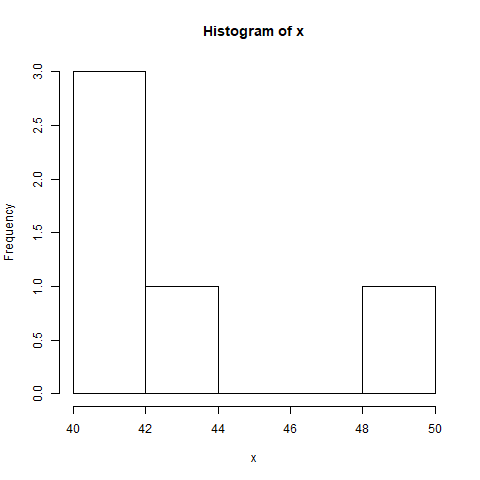
零偏度或对称
如果偏度系数等于 0 或近似接近 0,即![]() ,则称该图是对称的,并且数据是正态分布的。
,则称该图是对称的,并且数据是正态分布的。
例子:
Python3
# Required for skewness() function
library(moments)
# Defining normally distributed data vector
x <- rnorm(50, 10, 10)
# output to be present as PNG file
png(file = "zeroskewness.png")
# Print skewness of distribution
print(skewness(x))
# Histogram of distribution
hist(x)
# Saving the file
dev.off()
输出:
[1] -0.02991511图示:
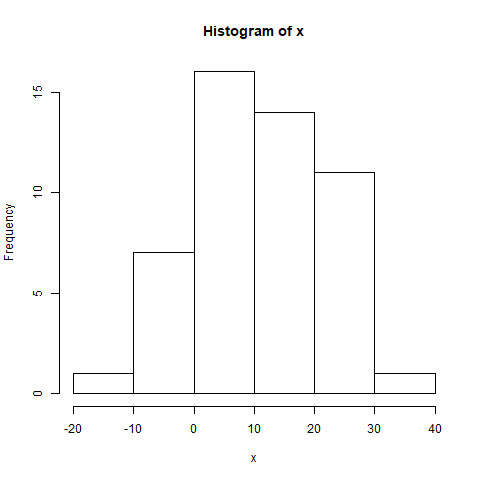
负偏斜
如果偏度系数小于 0 即![]() ,则该图被称为负偏斜,大多数数据值大于均值。大多数值都集中在图表的右侧。
,则该图被称为负偏斜,大多数数据值大于均值。大多数值都集中在图表的右侧。
例子:
Python3
# Required for skewness() function
library(moments)
# Defining data vector
x <- c(10, 11, 21, 22, 23, 25)
# output to be present as PNG file
png(file = "negativeskew.png")
# Print skewness of distribution
print(skewness(x))
# Histogram of distribution
hist(x)
# Saving the file
dev.off()
输出:
[1] -0.5794294图示:
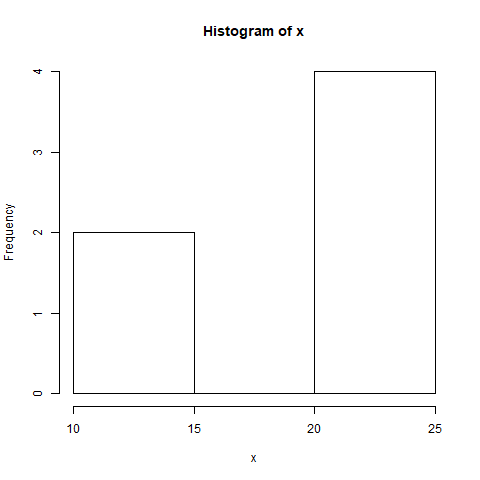
峰度
峰度是统计学中的一种数值方法,用于测量数据分布中峰值的锐度。
公式: 
在哪里,
![]() represents coefficient of kurtosis
represents coefficient of kurtosis ![]() represents
represents ![]() value in data vector
value in data vector ![]() represents mean of data vector
represents mean of data vector
n represents total number of observations
存在 3 种类型的峰度值,在此基础上测量峰的锐度。这些如下:
桔梗
如果峰度系数小于 3 即![]() ,则数据分布为 platykurtic。 platykurtic 并不意味着图表是平顶的。
,则数据分布为 platykurtic。 platykurtic 并不意味着图表是平顶的。
例子:
Python3
# Required for kurtosis() function
library(moments)
# Defining data vector
x <- c(rep(61, each = 10), rep(64, each = 18),
rep(65, each = 23), rep(67, each = 32), rep(70, each = 27),
rep(73, each = 17))
# output to be present as PNG file
png(file = "platykurtic.png")
# Print skewness of distribution
print(kurtosis(x))
# Histogram of distribution
hist(x)
# Saving the file
dev.off()
输出:
[1] 2.258318图示:
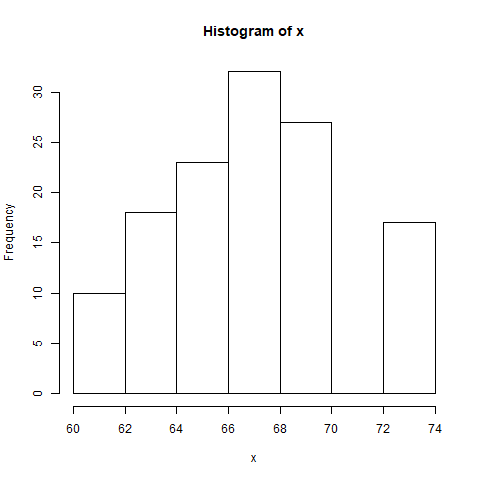
中峰
如果峰度系数等于 3 或接近 3,即![]() ,则数据分布是中峰的。对于正态分布,峰度值大约等于 3。
,则数据分布是中峰的。对于正态分布,峰度值大约等于 3。
例子:
Python3
# Required for kurtosis() function
library(moments)
# Defining data vector
x <- rnorm(100)
# output to be present as PNG file
png(file = "mesokurtic.png")
# Print skewness of distribution
print(kurtosis(x))
# Histogram of distribution
hist(x)
# Saving the file
dev.off()
输出:
[1] 2.963836图示:
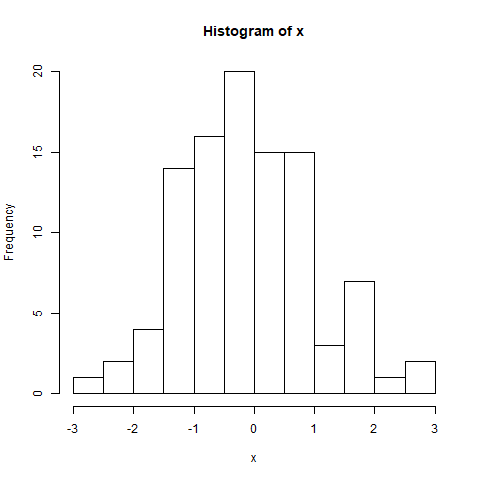
尖峰
如果峰度系数大于 3 即![]() ,则数据分布呈尖峰形,并在图上显示一个尖峰。
,则数据分布呈尖峰形,并在图上显示一个尖峰。
例子:
Python3
# Required for kurtosis() function
library(moments)
# Defining data vector
x <- c(rep(61, each = 2), rep(64, each = 5),
rep(65, each = 42), rep(67, each = 12), rep(70, each = 10))
# output to be present as PNG file
png(file = "leptokurtic.png")
# Print skewness of distribution
print(kurtosis(x))
# Histogram of distribution
hist(x)
# Saving the file
dev.off()
输出:
[1] 3.696788图示:
